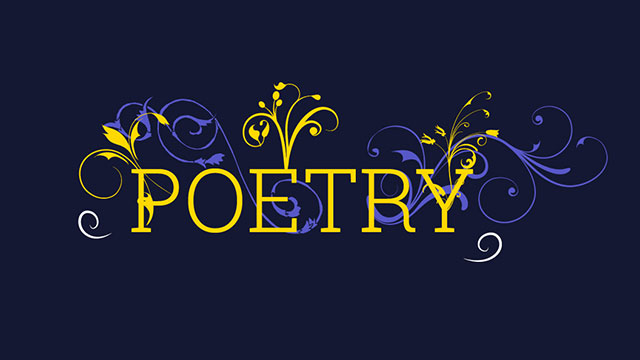Table of Contents
WRITING AND READING POETRY: HOW-TOS
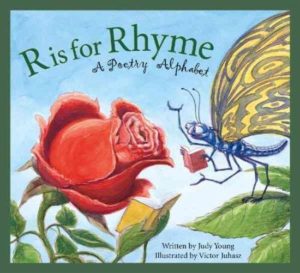
|
In Judy Young’s R is for Rhyme: A Poetry Alphabet (Sleeping Bear Press, 2010), each letter of the alphabet stands for a different poetic form or feature, with an example and explanation. A, ACROSTIC, for example, features an acrostic poem (“Drawing”), and explains how the title determines the first letters of each line of the poem. For ages 7-11. |
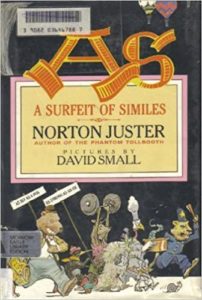
|
Norton Juster’s A Surfeit of Similes (William Morrow, 1989) is a delightful rhyming celebration of (many) similes: “As pure as an angel/As clever as zippers/As awkward as crutches/As friendly as slippers.” Readers will never forget what a simile is. Or a surfeit. For all ages. |
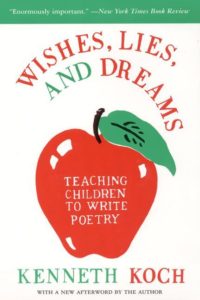
|
Kenneth Koch’s Wishes, Lies, and Dreams (HarperPerennial, 1999) – subtitled “Teaching Children to Write Poetry” – is a wonderful and inspirational collection based on Koch’s experiences with elementary-level students, crammed with teaching suggestions and examples of kids’ work. Kids write poems based on wishes, dreams, and colors; write poems while listening to music; create poems on the themes of “I used to/But now…” and “I seem to be/But I really am…” And much more. For ages 6-12. |
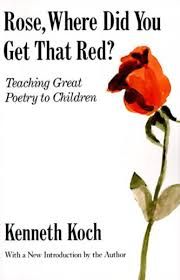
|
Kenneth Koch’s Rose, Where Did You Get That Red? (Vintage Books, 1990) – subtitled “Teaching Great Poetry to Children” – is one of my all-time favorites. The premise: kids read poems by famous poets and write related poems of their own. There are ten featured poem projects, for each of which is included a famous poem – among them William Blake’s “The Tyger” and Wallace Stevens’s “Thirteen Ways of Looking at a Blackbird” – with background information, teaching suggestions, and examples of student work. The second half of the book consists of a large anthology of additional poems, with accompanying writing suggestions. Very highly recommended. For ages 7 and up. |
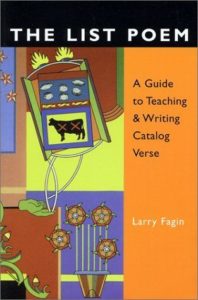
|
Larry Fagin’s The List Poem (Teachers & Writers Collaborative, 2000) is a wonderful guide to writing list or catalog poems, with many examples by both well-known poets and kids. Try a recipe poem or a how-to poem; invent a list poem of the beautiful, the happy, the sad, the magical, the infuriating. Adaptable for all ages. |
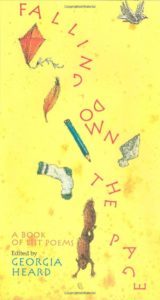
|
Edited by Georgia Heard, Falling Down the Page (Roaring Brook Press, 2009) is a collection of list poems, among them Jane Yolen’s “In My Desk,” Elaine Magliaro’s “Things to Do If You Are a Pencil,” Bobbi Katz’s “Things to Do If Your Are the Sun,” and Patricia Hubbell’s “Winter’s Presents.” Try versions of your own. For ages 8 and up. |
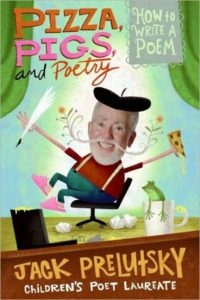
|
Jack Prelutsky’s engaging Pizza, Pigs, and Poetry: How to Write a Poem (Greenwillow Books, 2008) shows how he himself uses personal experiences to write poems, with examples from his own work. Included are suggestions for aspiring poets and a list of “poemstarts” to get things moving. For ages 8-12. |
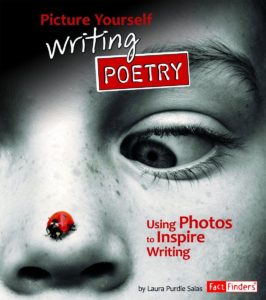
|
By Laura Purdie Salas, Picture Yourself Writing Poetry (Capstone Press, 2011) is a 32-page collection of photographs to be used as poem-starters, paired with helpful hints for beginning poetry writers. For ages 8 and up. |
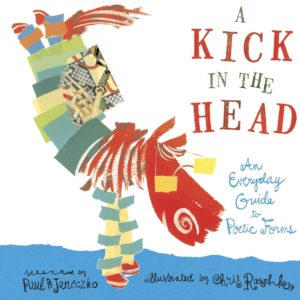
|
Paul Janeczko’s A Kick in the Head (Candlewick, 2009), subtitled “An Everyday Guide to Poetic Forms,” tackles the question: Do poems have rules? Yes, they sometimes do – which, Janeczko argues, makes writing a poem both challenging and fun. The book introduces 29 poetic forms, from the couplet and haiku to the aubade, elegy, villanelle, and pantoum. Clever illustrations accompany each example. For ages 8 and up. |
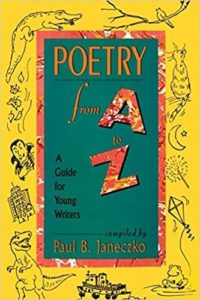
|
Janeczko’s Poetry from A to Z (Simon & Schuster, 2012) is an alphabetized guide to poetry forms and concepts, with illustrative examples by well-known poets and “Try this” projects for kids. For example, C stands for clerihews and curse poems; H for how-to poems and haiku; L for letter and list poems; and S for shape poems. For ages 9-12. |
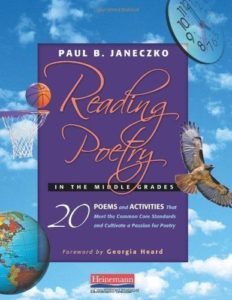
|
Also by Janeczko, Reading Poetry in the Middle Grades (Heinemann, 2011) is a collection of 20 poems, each with associated teaching suggestions, including pre- and post-reading activities, discussion topics, writing projects and templates, and a list of related poems. Among the poems are “Abandoned Farmhouse” by Ted Kooser, “A Poison Tree” by William Blake, “Summertime Sharing” by Nikki Grimes, “Ode to Family Photographs” by Gary Soto, and “Nothing Gold Can Stay” by Robert Frost. |
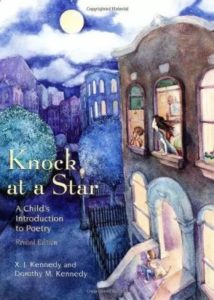
|
By X.J. Kennedy and Dorothy M. Kennedy, Knock at a Star (Little, Brown Books for Young Readers, 1999) is a wonderful anthology that encourages readers to consider what poems do and how they do it. Section one, “What Do Poems Do?,” groups poems by purpose: they variously Make You Smile, Tell Stories, Send Messages, Share Feelings, Help You Understand People, and Start You Wondering. Section two, “What’s Inside a Poem?,” groups selections by Images, Word Music, Beats That Repeat, Likenesses, and Word Play. “Special Kinds of Poetry” includes Limericks, Takeoffs, Songs, Show-and-Spell Poems, Finders-Keepers Poems, and Haiku; and a final section has helps for writing your own poems. Terrific. For ages 8 and up. |
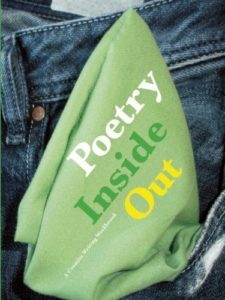
|
Poetry Inside Out (Two Lines Press, 2012), edited by Laura E. Davis and colleagues, is a poetry-and-translation-based curriculum in which kids study poems by twelve famous poets (Basho, Dante, Federico Garcia Lorca, and more) in their native languages, then translate them into English and use their translations as inspiration for poems of their own. Fascinating. For ages 9 and up. |
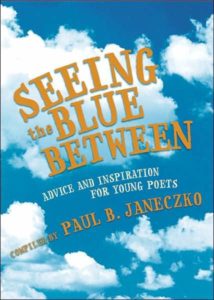
|
Compiled by Janeczko, Seeing the Blue Between (Candlewick, 2006) is a collection of 32 “letters of advice” to young poets from such established writers as Lee Bennett Hopkins, Jane Yolen, Lillian Morrison, and Jack Prelutsky. For ages 12 and up. |
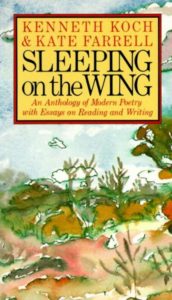
|
By Kenneth Koch and Kate Farrell, Sleeping on the Wing (Vintage, 1982) is a collection of poems with associated essays on reading poetry and suggestions for writing poems of your own. Featured poets include Walt Whitman, Emily Dickinson, Gerard Manley Hopkins, Wallace Stevens, William Carlos Williams, Ezra Pound, Allan Ginsberg, Frank O’Hara, Leroi Jones, and more. For ages 12 and up. |
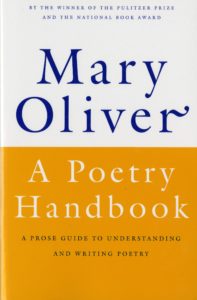
|
Mary Oliver’s A Poetry Handbook (Mariner Books, 1994) is a concise introduction to the art of poetry writing, with examples from the works of Robert Frost, Walt Whitman, Marianne Moore, Elizabeth Bishop, and others. Some things, Oliver explains, can’t be taught, but “can only be given;” other things, on the other hand, can. Topics covered include meter and rhyme, line and form, imagery, and free verse, with some final notes on revision (Oliver herself does many) and writing groups. For teenagers and adults. |
| Kenn Nesbit’s Poetry4Kids website features a long list of poetry projects and exercises, including experiments with a range of poetic forms (acrostic poems, concrete poems, found poems, haikus, limericks) and styles (apology, epitaph, and list poems, fractured nursery rhymes, riddle rhymes), and helpful hints on reciting poetry. Included is an extensive online poetry dictionary. | |
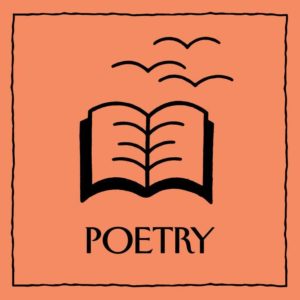
|
Learn, from the Poetry Foundation, has resources, information, and poems, categorized for children, teens, adults, and educators, along with poetry guides, a glossary of poetic terms, and more. |
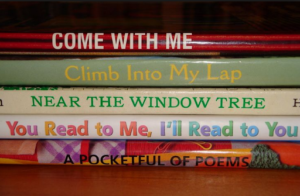 |
Nina Katchadourian’s Sorted Books Project began in 1993 and is still (all over the place) ongoing. The premise: choose a collection of particular book titles and group or stack the books such that the titles can be read in sequence from top to bottom. What a great way to write a poem. |
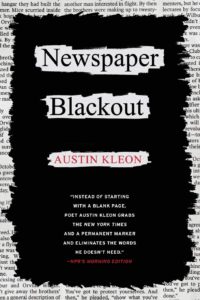 |
In Austin Kleon’s Newspaper Blackout (HarperPerennial, 2010), Kleon creates poems using newspaper articles and a black Sharpie, blacking out all the words he doesn’t want. What’s left is a poem. See some examples at the accompanying Newspaper Blackout website. |
|
|
Poem Generator has inspirational word hints and structural guidelines for helping writers produce many different kinds of poems – among them sonnet, free verse, cinquain, haiku, and concrete. |
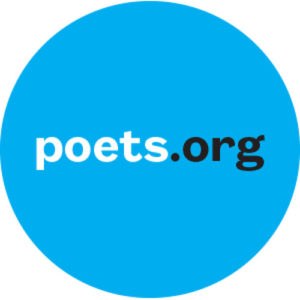
|
From the Academy of American Poets, the Lesson Plans page has a wide range of creative projects and activities, variously for elementary, middle, and high-school-aged kids. |
